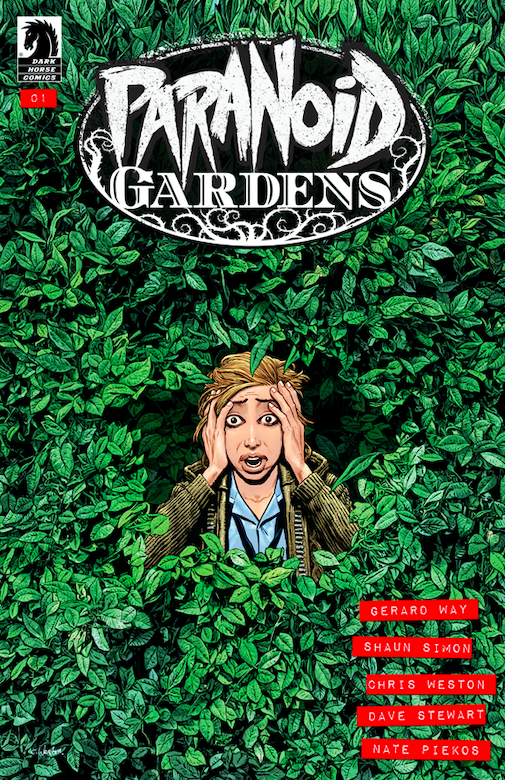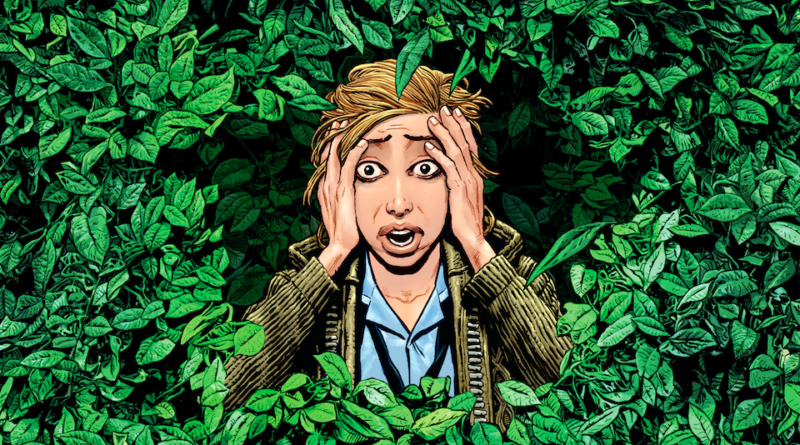INTERVIEW: Chris Weston invites you to ‘Paranoid Gardens’
Image courtesy of Dark Horse / Provided with permission.
Illustrator Chris Weston, known for his work on The Filth and Judge Dredd, is back with a new Dark Horse comic book series. Paranoid Gardens, which recently saw its debut issue hit shelves, comes from the minds of Gerard Way and Shaun Simon. Together the trio has crafted a tale that follows a nurse by the name of Loo. She works at a care facility where the residents are not human — that’s right, they’re aliens, ghosts, superheroes and other supernatural beings, according to press notes.
Recently Weston exchanged emails with Hollywood Soapbox to talk about all things Paranoid Gardens, including his fond memories of working on Judge Dredd and The Filth. He is joined on the project by colorist Dave Stewart and letterer Nick Piekos. Motohiro provides a variant cover for issue #1. Questions and answers have been slightly edited for style.
How did you develop the artistic style for Paranoid Gardens?
I don’t really think about developing an artistic style in much the same way I don’t think about speaking in an English accent. It’s just what comes out of me instinctively. I’ve always been fond of detailed, textured artwork, and I may have obsessive-compulsive tendencies that lend themselves perfectly to that kind of labour-intensive style. Similarly, I’m fond of prog rock, with all its noodly guitar solos and intricate time signatures. Most of Paranoid Gardens was hand-drawn to the sound of The Porcupine Tree and Rush at full volume. (Sorry, Gerard!)
I did make some presentation choices before I began the series. Influenced by Dave Gibbons’ approach to Watchmen, I decided to tell the story with as much clarity as possible. That meant no overlapping panels, nothing bursting out of panels and keeping all the artwork within the page bleed (with a few notable exceptions for dramatic effect). Paranoid Gardens is already a pretty weird story, so my duty was to illustrate it as clearly and comprehensibly as possible. Adding complicated layouts to a mysterious tale might have made it too confusing for some people, especially as I was also trying to appeal to readers beyond the regular comic-book fan audience. Again, I think that was a trick that Dave Gibbons pulled off with Watchmen, and that accessibility was probably a big factor in that book’s breakout success.
Did Gerard Way and Shaun Simon give a lot of direction on the “look” of the characters and story?
Gerard gave me a sheet of character designs he’d drawn himself. They were really good, and I stuck as close to them as I could. I told him they were great and that he should consider drawing the book himself, but fortunately for my bank balance, he declined. I did a tiny amount of development on his designs, as we have very different artistic styles, so I had to find a way to draw them that suited my more realistic approach. I had to work out what they looked like from different angles and with different expressions and postures.
What did you like the first time you read the story and learned of the character of Loo?
I’ve got a really bad memory, so by the time I’d finished drawing episode one, I’d completely forgotten where the story was going as indicated in the synopsis. I was discovering Loo’s adventures in the same way the readers would. What drew me to the project was how it reminded me of The Prisoner TV series, where a character is trapped in an apparently benign location — in this case, a care home — but strange and possibly sinister things are shifting beneath the surface. Loo is a much less self-assured character than the Number Six character who appeared in The Prisoner. Her confinement is brought about just as much by her own insecurities as any machinations of others. The walls she needs to break down are mostly of her own creation.
What were your early experiences like working on Judge Dredd?
Getting to draw Judge Dredd was a dream come true. It was literally the first professional job I was ever given. I was thrown right in the deep end, and, to be honest, I floundered. I think I got offered it too soon; I hadn’t learnt my craft yet or paid my dues. Pretty soon, the editors realised I was out of my depth, and I was taken off the strip. They gave me some “Future Shocks” to draw, which were short stories typically given to new and untested artists. At the time, it seemed like a kind of demotion, and I felt I’d failed. But I persevered with it and proceeded to learn my trade “on the job.” Subsequently, all my early work looks terrible to me, and those early Dredd stories I drew are a source of great embarrassment. Eventually, years later, I came back to Judge Dredd, and I think I may have redeemed myself somewhat. The best of my later Dredd strips have been gathered in a collection called Judge Dredd: Control. Most of them are written by Rob Williams, with whom I enjoyed a fruitful partnership on the strip. The Dredd strips we drew that feature a crocodile-headed character called Sensitive Klegg seem very popular with the readers.
The Filth continues to live on in the memories of comic book lovers. Did this project feel special to you?
Oh yes, definitely. It’s the comic I was drawing when I became a parent, so I associate it with a period of heightened emotions and sleep deprivation. I was listening to a lot of Morrissey and producing a page of artwork a day back then, which made it quite an intense phase in my life. I look back on those times as a kind of creative furnace, and I’m proud of what Grant Morrison and I forged. Ultimately, though, it did burn me out to a great degree. It took me a while to find my feet again after I’d completed The Filth.
What was the first comic book you ever read as a child?
It’s hard to say. I had an older brother, so comics were a constant presence in the house. The Asterix books by Goscinny & Uderzo were probably the first comic books I read myself. I mostly bought weekly British comics like Lion, Valiant, Victor and Bullet. I didn’t really read that many American books aside from Superman. Two comics changed my life: The first was a weekly comic called Vulcan that featured a strip called The Trigan Empire. That was a sort of “Roman Empire in space” story that was beautifully painted by Don Lawrence. He eventually became my mentor. The other comic was 2000 AD weekly, where I discovered the work of Brian Bolland, Brendan McCarthy, Mick McMahon, Cam Kennedy and Dave Gibbons. All of these guys are my artistic heroes.
By John Soltes / Publisher / John@HollywoodSoapbox.com
Paranoid Gardens, illustrated by Chris Weston, is now available from Dark Horse Comics. Click here for more information.


